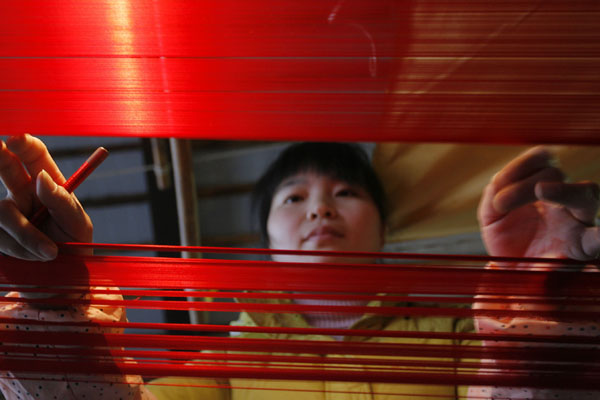 |
|
The age-old craftsmanship of brocade weaving still thrives, thanks to the dedicated artisans with the Nanjing Brocade Research Institute. Traditional brocade takes on a modern look at a Nanjing fashion show.Photos provided to China Daily
|
Highly skilled workers employ traditional techniques to create brocades once worn by emperors.
Nanjing was the ancient capital of six dynasties in China, and in August, it will come under the limelight again as the host city of the 2nd Asian Youth Games. Its rich history and cultural heritage are sure to impress first-time visitors.
There are many traditional crafts still preserved in this historic destination.
Weavers in the city today are still making Nanjing cloud-patterned brocade, considered the most extravagant silk fabric that was produced exclusively for emperors and imperial court officials.
It was called yunjin or cloud-patterned brocade because its woven motifs were as beautiful and diverse as clouds in the sky.
The techniques of weaving this brocade have a history of more than 1,500 years. They were, however, almost on the brink of extinction until 1979 when the Nanjing Brocade Research Institute tried to replicate a dragon robe that had been unearthed from one of the Ming Tombs in Beijing.
The robe was in tatters and its brilliant colors were fading from exposure to air. Researchers concluded that it had been made in 1619 during the Ming Dynasty (1368-1644). This was the period when the cloud-patterned brocade production was at its peak and private workshops were allowed to develop because of rising demands from the imperial court.
It took specialists five years to resuscitate the ancient skills and recreate the brilliant luster and colors of this historic robe.
The design features dragons and symbols of longevity such as cranes, and it was embroidered with gold thread and peacock feathers.
One major hurdle was finding the appropriate loom.
Zhou Shuangxi, the youngest member of the restoration team, explains that they found two looms at one household and had them resembled, but they were very worn out and the wooden parts had become moldy.
A yunjin loom is a large and complicated piece of machinery. It measures 5.6 meters long, 1.4 meters wide and 4 meters high, and is made up of 1,924 small components. It is manually operated by two weavers and involves a distinctive technique to make the jacquard patterns.
This is a weaving process that dates back to the 1700s, named after its French inventor, Joseph Marie Jacquard. Jacquard weaving cannot be done on modern machines.
We recommend:
